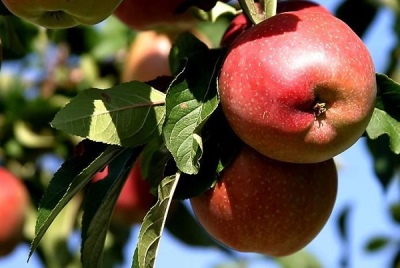
- Authors: Botanical Garden of Moscow State University
- Taste: sweet and sour
- Scent: there is
- Fruit weight, g: 160
- Fruit size: average
- Yield: up to 160 kg
- The beginning of fruiting varieties: for 6-7 years
- Ripening terms: autumn
- Removable maturity: end of September
- Appointment: universal
Among the large number of apple varieties and hybrids, the Beauty of Moscow is considered one of the leading. The plant is unpretentious and versatile. The fruits of the variety are distinguished by high taste indicators, suitable for consumption both fresh and canned. The amazing keeping quality allows you to store the fruits in appropriate conditions until spring.
Breeding history of the variety
The originators of the Beauty of Moscow are the breeders of the Botanical Garden of Moscow State University. The famous varieties Welsey and Antonovka were used in the work.
Description of the variety
The beauty of Moscow is a powerful, rather spreading tree 3.5-4 meters high, with a dense, rounded crown painted in gray tones. The brownish branches are skeletal and horizontal. Fruiting occurs at the ends of the shoots of the previous year. Shoots are slightly pubescent, with short internodes, medium-sized lenticels with a convex shape. The branches are covered with dense large leaves with crenate edges.
Features, pros and cons
The apple tree has serious positive qualities, therefore it is of interest to gardeners. Pros:
long shelf life;
excellent frost resistance;
good consumer properties;
disease resistance.
The downside can be considered the need to form a crown, since without this it overgrows to the point of obstruction of fresh air.
Ripening and fruiting
The variety is known for its early maturity - seedlings begin to bear fruit as early as 6-7 years after planting. Fruits ripen late - they reach removable maturity at the end of September, in October.
Growing regions
Since the variety was bred specifically for the Moscow region, the apple tree is adapted for the Leningrad region, the Moscow region and central Russia.
Yield
The mass of fruits removed from an adult tree is 160 kg.
Fruits and their taste
Light green fruits, with a blush at the time of removable ripeness, have the correct shape and weight up to 160 grams. Juicy dense pulp has a sweet and sour taste and a pleasant aroma.

Growing features
For planting, sunny places are chosen, keeping the distance between the holes at 4-5 meters. When choosing a location, you need to take into account the occurrence of groundwater - they should not be closer than 2 meters from the soil surface. It is better if the place is protected from cold winds.
For planting young seedlings, pits 80x80 cm in size are prepared. The excavated soil is enriched with organic matter and mineral fertilizers. Young trees will need support, so a peg is installed in the hole, to which a fragile trunk can later be tied.
Caring for the plant consists in weeding and watering the trunk circle. Loosening will help oxygenate the soil.
The grown tree will need mandatory sanitary pruning and crown formation, otherwise strong thickening threatens the colonization of parasites and fungi. Sanitary pruning is carried out in spring and autumn, removing damaged, diseased and dried shoots. For the formation of the crown, special knowledge is required, such as the structure of the tree, methods and pruning schemes. It is the formation of the crown that helps to obtain stable yields and protect the health of the tree. Formation begins in the year of planting and the development of the plant is carefully monitored.



Pollination
The beauty of Moscow is known as a self-fertile fruit tree, so apple trees with the same flowering period should grow nearby, which can help in pollination. There are many suitable varieties, for example Zhigulevskoe, Grushovka, Antonovka and many others.
Top dressing
In the first couple of years, young trees do not need additional fertilizing if the soil was properly filled during planting. Then the apple tree will need nutrients. Fertilizers with nitrogen are applied in the spring, phosphorus-containing substances in the summer, and organic matter in the fall.

Frost resistance
The variety is distinguished by good frost resistance and tolerates a drop in temperature to minus 32-35 degrees.

Diseases and pests
The apple tree has a strong immune system and is well resistant to diseases and pests. Scab is somewhat more dangerous for her, therefore, preventive measures are needed in the form of treatment with insecticides and fungicides. Particular attention must be paid to ongoing surveillance to detect cancer. This is one of the worst scourges for an orchard. Cancer is able to destroy it within two years.

The apple tree is a popular fruit crop among gardeners. It can be found in many summer cottages. But at the same time, such trees are often affected by various diseases. It is very important to recognize the disease in time and carry out the necessary procedures for a speedy recovery.Otherwise, the fruits will be spoiled, and the tree itself may die altogether.












































































